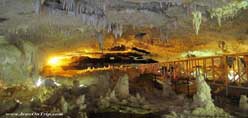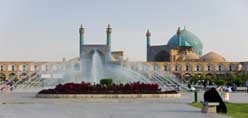Yazd at a Glance
Yazd, A Desert Paradise
The word Yazd means, feast and worship, the city of Yazd has resisted the modern urbanization changes and maintained its traditional structure. The geographical features of this region have made people developed special architectural styles. For this reason, in the older part of the city most houses are built of mud-bricks and have domed roofs. These materials served as insulation preventing heat from passing through.With an area of 131,575 km Yazd is the fourth largest province in Iran located in the central plateau on the rim of the vast desert of Kavir-e-Lut.The province consists of 11 towns, 23 townships and 51 villages, bordering Semnan province to the northwest, Esfahan province in the west, Fars province in the south and southwest, South Khorasan province to the east, Khorasan Razavi province in the northeast and Kerman province in the east and southeast.
History
The famous but sporadic historical remains of Yazd evoke the opulent life style of its former dwellers, recounting a long history full of charm. The city has a history of over 3,000 years, dating back to the time of the Median empire, when it was known as Ysatis (or Issatis). The present city name has however been derived from Yazdegerd I, a Sassanid ruler. The city was definitely a Zoroastrian centre during Sassanid times. After the Arab Islamic conquest of Persia, many Zoroastrians fled to Yazd from neighbouring provinces. The city remained Zoroastrian even after the conquest by paying a levy, and only gradually did Islam come to be the dominant religion in the city.Stone tools found in the Shirkouh valleys, rock paintings in Ernan, pottery and patterns found in the Narin Fortress dating back to the Elamite era, the magnificent caves and picturesque works of architecture, ceremonial-religious centers like Pir-e-Sabz, Pars Banou and Pir-e-Naraki…evoke the existence of ancient religions and faiths widespread at the time, albeit before the spread of Zoroastrian.
The 4000- year-old cypress in Abarkouh, the existence of pre-historic civilization in Gharbal Biz, and the coins minted in Meybod at the time of Pouran Dokht of the Sassanid Dynasty are indeed manifestations of the magnificent history of older civilizations.
Because Yazd was located on the crossroad enjoining eastern and western parts of Iran, the strategically important city fell in the hands of Muslim conquerors in the first century of the Islamic era. The dynasties of the Kakuyids, Atabegs, Mongols, Mozaffaris, Timurids, Qajar and Pahlavi ruled the province over centuries.
Yazd is the one of the most ancient and historical cities known for its mud-brick houses. The world famous city of Yazd with an area of 24 km is the provincial capital, consisting of two districts and the towns of Hamidia, Shaheidiye, Zarch, and five villages namely Fajr, Fahraj, Elahabad, and Mohammadabad.
Active ImageThe city has a population of over half a million, of which 481,000 live in the urban areas and 41,000 in the rural regions.
Because of its remote desert location and the difficulty of approach, Yazd had remained largely immune to large battles and the destruction and ravages of war. For instance, it was a haven for those fleeing from destruction in other parts of Persia during the invasion of Genghis Khan. It was visited by Marco Polo in 1272 who remarked on the city's fine silk-weaving industry. It briefly served as the capital of the Muzaffarid Dynasty in the fourteenth century, and was sieged unsuccessfully in 1350–1351 by the Injuids under Shaikh Abu Ishaq. The Friday (or Congregation) Mosque, arguably the city's greatest architectural landmark, as well as other important buildings, date to this period. During the Qajar dynasty (18th Century AD) it was ruled by the Bakhtiari Khans.Under the rule of the Safavis (16th century), some people emigrated from Yazd and settled in an area which is today on the Iran-Afghanistan border. The settlement was named Yazdi. This place is currently on the Iran-Afghanistan border in the province of Farah, in Farah city in Afghanistan. Even today, these people speak with an accent very similar to that of the people of Yazd.
Here is Marco Polo writing about Yazd:
Active ImageYasdi also is properly in Persia; it is a good and noble city, and has a great amount of trade. They weave there quantities of a certain silk tissue known as Yasdi, which merchants carry into many quarters to dispose of. The people are worshippers of Mahommet.
When you leave this city to travel further, you ride for seven days over great plains, finding harbour to receive you at three places only. There are many fine woods [producing dates] upon the way, such as one can easily ride through; and in them there is great sport to be had in hunting and hawking, there being partridges and quails and abundance of other game, so that the merchants who pass that way have plenty of diversion. There are also wild asses, handsome creatures. At the end of those seven marches over the plain you come to a fine kingdom which is called Kerman. The Travels of Marco Polo, Marco Polo, translated by Henry Yule
Yazd is of foremost importance as a centre of Persian architecture. Because of its climate, it has one of the largest networks of qanats in the world, and Yazdi qanat makers are considered the most skilled in Iran. To deal with the extremely hot summers, many old buildings in Yazd have magnificent windcatchers, and large underground areas. The city is also home to prime examples of yakhchals, the latter of which were used to store ice retrieved from glaciers in the nearby mountains. Yazd is also one of the largest cities built almost entirely out of adobe.
Yazd's heritage as a centre of Zoroastrianism is also important. There is a Tower of Silence on the outskirts, and the city itself has a Fire Temple, which holds a fire that has been kept alight continuously since 470 AD. Presently, Zoroastrians make up a significant minority of the population, around 20 - 40,000 or 5 to 10%.
Built in 12th century and still being in use, Jame mosque of Yazd is an example of finest Persian mosaics and excellent architecture. Its minarets are the highest in the country.
Kabir Jameh Mosque
Active ImageThe magnificent Jameh Mosque is a major landmark almost always crowded by tourists from in and outside the country. The huge structure overlooks the vast expanse of the desert evoking the history of older civilizations hidden in the haze of time.
According to historians, the mosque was constructed on the site of the Sassanid fire temple, and A’la Al-Dowleh Garshasb started building the charming mosque. An earlier mosque was constructed on the order of A’la Al – Dowleh Kalanjar in the 6th century A.H. However the main construction of the present structure was ordered by Seyyed Rokn Al- Din Mohammad Qazi.
The Jameh Mosque with its spectacular view boasts picturesque plasterworks, charming dome-chamber, courtyard, elegant tile works and towering minarets.
The cluster of spacious iwans, magnificent rotunda and its surrounding space are world famous artworks commanding a view like no other. The soaring iwans full of picturesque mosaic tiles, exquisite arabesque patterns and gorgeous brick work offer a spectacular vista.
Active ImageElegant patterns of brick work and the priceless inscription of mosaic tiles bearing angular Kufic script create a sense of timeless beauty. The main prayer niche, the one which is located below the dome, is decorated with elegant mosaic tiles and eye-catching inscriptions. And on the two star-shaped inlaid tiles, the name of the prayer niche builder (777A.H.) sparkle with added beauty.
The impressive dome is of continuous double shell on which the paintings of floral patterns demonstrate their own charm. On their stalks the phrase of Al-Mulk ul-Lellah in Kufic script is adorned.Two towering minarets dating back to the Safavid era measure 52 meters in height with a diameter of 6 meters. The minarets fell into ruin in the 1930s but were rehabilitated soon after.One of the minarets boasts two flights of stairs seen as a unique work of art and craftsmanship.
Amir Chaqmaq Complex
Active ImageDuring Timurid rule Amir Jalal Al-Din Chaqmaq-e-Shami was appointed ruler in Yazd. He and his wife ordered the construction of a spacious square ringed by a water reservoir, a house for dervishes, a school, a caravanserai, a well, and a mosque.The grandiose mosque boasts a huge dome, an elegant platform, and two spacious summer and winter dome chambers.An alluring slab of marble is set in the prayer niche beautifully ringed by mosaic tiles bearing the verses of the Holy Qur’an.Within the 9th century mosque a marble stone recounts the names of the founders and date of construction
Dolatabad Garden
Active ImageMohammad Taqi Khan known as the Great Khan was the progenitor of the dynasty of Khans in Yazd. He built a qanat named Dolatabad. Later he ordered the construction of the estate of Dolatabad Garden as his residence along the waters flowing from the qanat.The amazing and astounding estate has a vestibule, a huge wind tower, a veranda covered with mirrors, and a splendid facade. The lush garden is a paradise with trees like the pine and, cypress piercing the skies, an assortment of flowers, fruit trees, vineyards…offering a green carpet panorama.The soaring 34 meter wind tower, the highest in the world, extends to the envious estate a great beauty and preoccupies the minds of visitors young and old.
Fire Temple (Fire of Varahram)
The impressive site was built with contributions from Yazd and India-based Zoroastrians (Parsis) amid a spacious courtyard – a demonstration of the architectural style of the Achaemenid Era (Persepolis). The elaborate pattern of ‘Farvahar’ sparkles atop the façade.Active ImageA centuries-long burning fire is the magnet that attracts millions of tourists throughout the year.It is said that the fire has been burning for 1,520 years. The sacred fire was once housed in the Nahid Fire Temple in the southern Fars province. Later it was moved to the village of Haftador in the vicinity of Aqda, then to the village of Torkabad in Ardakan.The fire was kept intact in the cave of Eshgeft-e-Yazdan and finally was brought to Yazd city in 1325 and kept in the neighborhood of Moubedan. Now it is housed in the newly-built and Fire Temple in one of the elegant districts of the city.The fire of Varahram burns in a glamorous brass cup in a special chamber within the building above the ground floor and away from sunlight, wind and rain.
.....
.....
.....

.jpg)



























